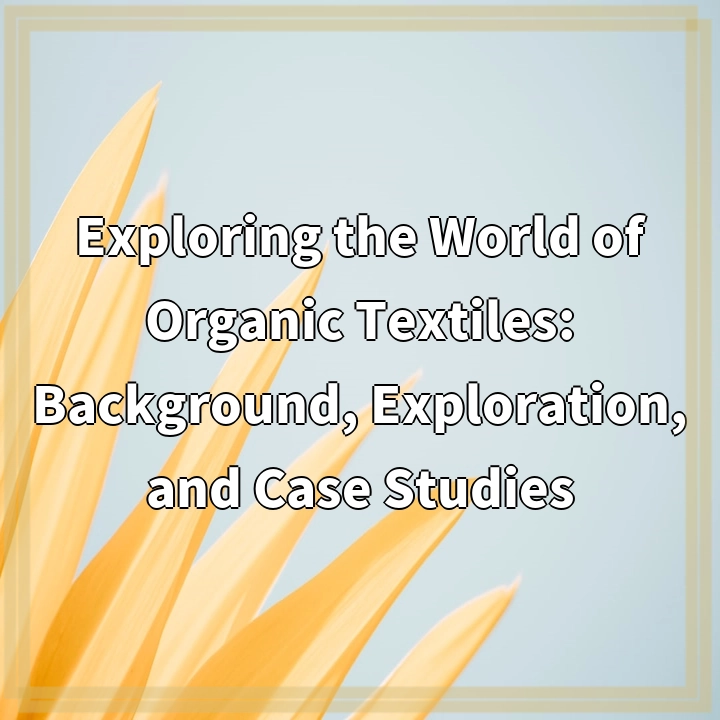Physical Address
304 North Cardinal St.
Dorchester Center, MA 02124
Physical Address
304 North Cardinal St.
Dorchester Center, MA 02124

Organic textiles refer to fabrics and materials that are produced using organic fibers, such as cotton, hemp, and silk. These fibers are grown without the use of synthetic chemicals like pesticides or fertilizers. Organic textile production aims to minimize harm to the environment, conserve resources, and ensure the health and safety of workers and consumers.
As we delve into the realm of organic textiles, it becomes clear that the production and use of these materials are not without challenges. Let’s explore some of the real-world problems associated with organic textiles:
The cultivation of organic fibers often requires more manual labor, proper land management, and careful pest control alternatives. These factors contribute to higher production costs compared to conventional textile production. As a result, organic textiles may be more expensive for consumers to purchase, limiting their accessibility to a wider market.
The demand for organic textiles is steadily increasing as people become more conscious of sustainability and environmental ethics. However, the supply of organic fibers still falls short of meeting this demand. Since organic farming methods require a longer transition period and lower yields compared to conventional methods, there is a limited availability of organic fibers to meet the growing demand.
With the rise in popularity of organic textiles, some companies may engage in “greenwashing.” Greenwashing refers to the deceptive marketing practice of making unsubstantiated or misleading claims about the organic or eco-friendly nature of their products. Lack of proper certification and regulation can make it difficult for consumers to identify genuinely organic textiles, leading to confusion and distrust in the market.
The production of organic textiles often involves a complex global supply chain that includes multiple stakeholders, from farmers to manufacturers to retailers. Ensuring transparency and traceability throughout this supply chain can be challenging. Without proper monitoring and controls, there is a risk of potential violations of organic standards, such as the mixing of organic and non-organic fibers. This further reinforces the need for robust certification and verification systems.
Although awareness about organic textiles is growing, there is still a need for more education and information dissemination. Many consumers are not fully aware of the benefits of organic textiles or the potential harm caused by conventional textile production. Raising awareness and providing accessible information can help bridge this gap and encourage more informed purchasing decisions.
The challenges associated with organic textiles can be overcome by implementing the following solutions:
Channeling resources into research and development can help improve organic farming techniques, develop more resilient organic fibers, and enhance the overall efficiency and productivity of organic textile production. This investment can lead to reduced costs, increased yields, and a wider availability of organic fibers in the market.
Governments can play a crucial role in promoting the organic textile industry by providing financial incentives, grants, and subsidies to farmers and producers who adopt sustainable practices. This support can help offset the higher costs associated with organic production, making organic textiles more affordable and accessible to consumers.
Strengthening certification and regulation processes for organic textiles can help address concerns about greenwashing and ensure the authenticity of organic products. Governments and certifying bodies can establish rigorous standards, conduct regular inspections, and enforce penalties for non-compliance to maintain the integrity of the organic textile market.
Collaboration among stakeholders in the supply chain is necessary to improve transparency and traceability. Implementing systems for tracking organic fibers from farm to finished product can help detect and prevent any mixing or contamination. Emphasizing accountability and encouraging open communication can build trust and ensure that organic textiles meet the required standards.
Educating consumers about the benefits of organic textiles and the environmental and health impacts of conventional textiles is crucial. Increasing awareness through public campaigns, labeling initiatives, and partnerships with environmental organizations can empower consumers to make more informed choices and support the growth of the organic textile industry.
Exploring the world of organic textiles reveals both the potential and the challenges associated with this sustainable alternative to conventional textile production. While organic textiles offer numerous environmental and health benefits, it is important to address the real-world problems discussed above to ensure the growth and success of the organic textile industry. By implementing the suggested solutions, the challenges surrounding organic textiles can be addressed, paving the way for a more sustainable and accessible industry. Collaboration, innovation, and informed consumer choices are key to realizing the full potential of organic textiles and fostering a healthier and more environmentally friendly future.
If you’re wondering where the article came from!
#